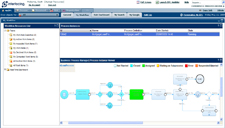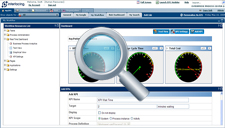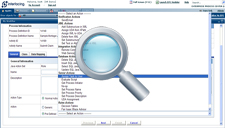EPC Workflow
With EPC, users can automate selected human and system-centric business processes with an advanced integrated Workflow engine, allowing you to align your process workflow with a Service Oriented Architecture (SOA). Manage high level processes with the reassurance that they will be executed according to company strategies while making efficient use of IT systems and human resources. It is important to note, however, that the EPC is not limited to this particular workflow engine – clients may integrate their existing workflow engines with ease, giving users added flexibility.

|
Execute in BPMN On-The-Fly Task Automation Editing Business Activity Monitoring (BAM) |
Integrated Business Rules Automated Problem Solving Support of eForms |
Integrate with Existing Systems |
Execute in BPMN
EPC models and automates processes using the BPMN standard notation, providing both IT and business users with one single version enabling true “round-tripping.” Additionally, instead of simply providing end users with data sheets of execution statistics, the Workflow engine’s BPMN execution provides a graphical representation of every instance of the process and displays which activity is currently being executed. EPC workflow can also generate XPDL & BPEL code as a means to integrate with 3rd party modeling tools & engines.
On-The-Fly Task Automation Editing
With an intuitive interface, process owners are able to adapt process instances on-the-fly within the Web Portal instead of adapting entire process definitions – all using the simple drag and drop features of the EPC Web. In addition, process owners can create ad hoc process execution instances (rewind, skip activities, etc.) for unique circumstances.
Business Activity Monitoring (BAM)
The BAM engine facilitates real-time performance tracking as key performance indicators (KPIs) can be associated with tasks and processes. Process execution analysis will reveal the performance of each process, allowing managers to make appropriate changes to the process to reflect business policies and performance needs. In addition, the integrated Cognos BI/Performance module allows for easy drag and drop report building and scheduling. With BI, users are able to create reports using data from multiple system sources for comprehensive analysis.
Integrated Business Rules
The Workflow engine contains an integrated Business Rules engine which allows for rule-defined execution. Business Rules can be defined and referred to by each executable process. This allows for rules to be handled independently of processes, ensuring that minimal process-change is required when business rules are modified as policies, regulations, and strategies change over time.
Automated Problem Solving
The BAM engine provides user-defined trouble notification functions. Managers may create customized performance trouble thresholds, and if the real-time performance data reported by the BAM engine penetrates this threshold, the EPC Workflow engine will escalate processes and kick-off risk mitigation efforts. Automatic notification emails can be sent out to the appropriate resources, and standard operating procedure processes can be immeditely executed by the Workflow engine for automated problem solving.
Support of PDF e-Forms & e-Signatures
The EPC Workflow engine supports web forms and PDF e-Forms. PDF e-Forms will help to expedite your transition from paper based to paperless processes. The PDF e-forms builder allows users to create new forms, customize pre-defined templates or even load current familiar Word and PDF forms; additionally, users can save a local copy of the completed form on their hard drive, and attach supporting documents. With your online processes the need for printing, shuffling of physical documents and archiving space, is minimized. EPC engine has the ability to associate forms with specific tasks; this dramatically increases productivity and the flow of information.
In addition, EPC workflow engine has e-Signatures. e-Signatures are a stylized script bind to a person responsible for the integrity of a process. With e-Signatures, business users can perform your administrative duties while traveling, without scarifying compliance rigor.
Integrate with Existing Systems
The workflow engine provides connectors to integrate with existing systems in organizations to provide maximum versatility. Integration is facilitated by a SDK/Model API. Servers communicate with external systems via adapter classes such as JMS, Database, LDAP, WebDAV, and SMTP, which is accomplished via JAVA Actions and Agents. In this case, Java Actions are Java method calls involved in the execution of a process node, whereas Agents are background programs that communicate both externally and with the EPC Workflow.











